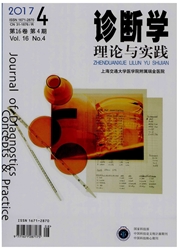

 中文摘要:
中文摘要:
目的:探讨肿瘤特异性人端粒酶反转录酶(hTERT)启动子调控的人钠碘同向转运体(hNIS)的特异性抗肿瘤作用。方法:将质粒pcDNA3.1-CMV-hNIS中的hNIS cDNA亚克隆至含hTERT核心启动子的质粒载体pGL3-hTERT-luc中,以构建质粒pGL3-hTERT-hNIS,并以质粒pGL3-hTERT-luc及pcDNA3.1-CMV-hNIS分别作为阴性对照及阳性对照,然后采用脂质体将其转染至人胚肺成纤维细胞MRC-5及肿瘤细胞HeLa、A549和U87中,采用荧光定量聚合酶链反应(PCR)检测hNIS mRNA水平;免疫细胞化学法及流式细胞术(FCM)检测hNIS蛋白的表达情况;摄碘实验验证hNIS蛋白的功能;同时采用MTT观察131I的细胞杀伤作用。结果:成功构建质粒pGL3-hTERT-hNIS,转染4种细胞后,3种肿瘤细胞的hNIS mRNA水平明显高于MRC-5细胞(P〈0.05)。3种肿瘤细胞均可表达hNIS蛋白,而MRC-5细胞不表达。与Na125I孵育30 min时HeLa、A549和U87细胞的摄碘量分别是阴性对照组的25倍、20倍和18倍。131I照射7 h后,3种肿瘤细胞的相对存活率显著下降(P〈0.05)。结论:hTERT启动子调控hNIS基因在肿瘤细胞中特异性表达,这些细胞可特异性摄碘并被其有效杀伤,为行进一步体内实验奠定基础。
 英文摘要:
英文摘要:
Objective To study the anti-tumor effect of human sodium iodide symporter (hNIS) regulated by human telomerase reverse transcriptase (hTERT) promoter. Methods The hNIS cDNA from plasmid pcDNA3.1-CMV-hNIS was subcloned into plasmid vector pGL3-hTERT-luc with hTERT core promoter to form the recombinant plasmid pGL3- hTERT-hNIS.The plasmid was transfected into cancer cell lines (HeLa,A549,U87) and human embryo puhnona~y fibrob- last (MRC-5) using lipofectamineTn2000. The level of hNIS mRNA was detected by quantitative real-time RT-PCR. The hNIS protein was detected by immunocytochemistry and flow cytometry . Iodide uptake assays were used to confirm the function of hNIS protein. The cytotoxicity of ^131Ⅰ to transfeeted cell lines was detected by MTT assay. Results The plasmid pGL3-hTERT-hNIS was successfully constructed. After transfecting into four cell lines, the results of quantitative RT-PCR showed that the relative expression of hNIS mRNA in three cancer cells were higher than MRC-5 cells (P〈0.05). In im- munocytochemistry assay and flow cytometry, the result showed that the hNIS protein was not expressed in MRC-5 but in HeLa, A549, U87 at different levels. Similarly, the uptake of ^125Ⅰwas found in HeLa, U87, A549 cells but not in MRC-5, and the uptake rates in HeLa, U87, A549 cells was 25, 20, 18 folds higher than that in negative control group, respective- ly. In MTF assay, the relative survival rates of three cancer cells decreased significantly after the treatment with ^131Ⅰ for 7 h (P〈0.05). Conclusions The recombinant plasmid regulated by hTERT promoter can confer the tumor cell lines to ex- press hNIS , and these cell lines are killed by the selectively accumulated ^131Ⅰ. This study provides the foundation for fur- ther in vivo study.
 同期刊论文项目
同期刊论文项目
 同项目期刊论文
同项目期刊论文
 期刊信息
期刊信息
